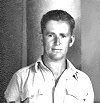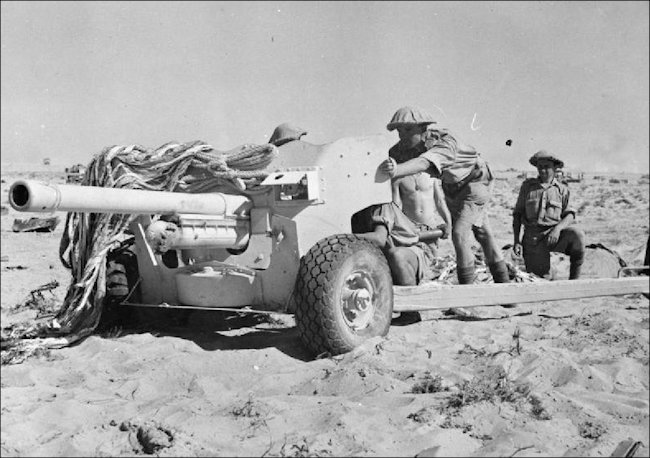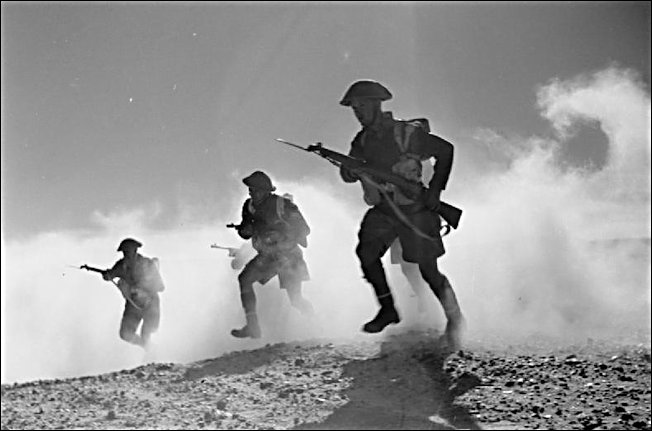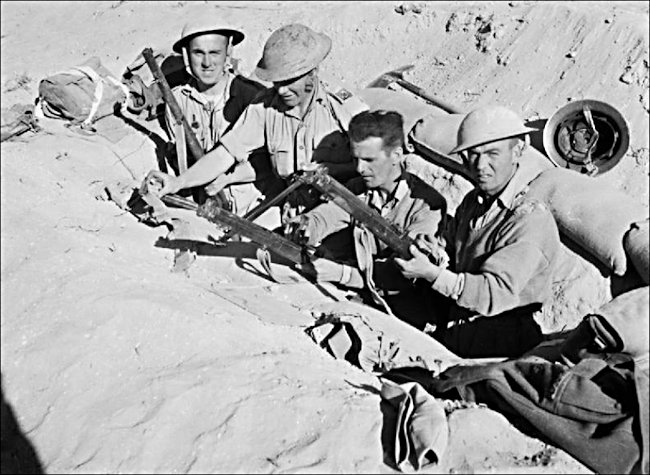2nd Battalion Kings Royal Rifle Corps at the Battle or Mareth March 1943
Len Moore fought with the 2nd Battalion Kings Royal Rifle Corps 2/KRRC across the deserts of North Africa during WW2 from 1941 to 1943. His unit took part in the Battle or Mareth March 1943.

Len Moore 2nd Battalion Kings Royal Rifle Corps
The Battle or Mareth 24-28 March 1943
This account of the part the 2nd Battalion Kings Royal Rifle Corps took during the Battle of Mareth was written by The Commander of the 7th Armoured Division, Major-General Erskine. He described this operation by the 2nd Battalion KRRC as "most creditable and had an important bearing on our success in breaking the Mareth Line".
On the night 24th/25th March, B Company advanced and took Hamiam es Srhira, Pt. 221, being greatly hampered by S mines during the approach, but meeting with no further opposition. During the whole of the day, 25th March, they held this position, being shelled continuously.
Night Advance.
At 23.00 hrs. the following night, 25th/26th March, C Company advanced towards Pt. 308 with the intention of attacking and occupying it. A party of sappers led the way, sweeping a path, and followed by 11 and 12 Platoons. This was a lengthy and tedious job and their difficulties were increased by having to improvise a road over the steepish wadis and hummocks to enable vehicles to pass. Half-an-hour after starting one of their vehicles went up on a mine, and the explosion brought down one round of gunfire on the gap.

British 6pdr gun ready for action in the Western Desert
The advance continued slowly with no further alarms, and at approximately 4 0'clock in the morning a point some 500 yds. South of the 308 feature was eventually reached. As no noise or movement could be heard, the commander decided to send a reconnaissance party of one Officer and a Section up each of the left and right sides of the feature. On receiving the report "Clear of enemy" a signal was sent back for the trucks, machine guns and Artillery OOP. to come forward along the route which had been made marked with tape.
The hill was then occupied, with 1 Platoon on the right, 12 Platoon on the left, whilst the machine guns and mortars remained at the bottom of the feature. A line was soon run to the Artillery O.P. and Pt. 208 was selected as the first target, but the enemy here appeared to be too well dug in for the shelling to be of much effect. Four enemy 75mm. guns which were thought to be on the other side of the hills and mortars then replied to our fire and were uncomfortably heavy.
A Long Day's Fighting.
At 11.00 hrs., 26th March, a small patrol from B Company, March including one Officer, set out to reconnoitre the ground as far 26th North as the road junction. This patrol was last seen moving North along the track at about 12.30 hrs. and shortly afterwards small arms fire was heard. Although due back at 15.00 hrs., they did not return, and a prisoner of war subsequently confirmed that they had been captured.
At midday a small party of enemy infantry, adopting Commando tactics, managed to crawl on their stomachs up the eastern edge of the 308 feature, aided by the difficulty of keeping watch this side, as the platoon who were looking out in that direction were in full view of the enemy strong point at 208. The enemy, having concealed themselves behind a knoll on the top right-hand side of the 308, sniped and flung hand grenades at 11 Platoon.
This meant that only 60 yards separated them from the platoon who, hiding behind rocks and firing at anything which appeared on the skyline, managed to push them off and eventually restore our observation. Throughout the afternoon the 75 mms. shelled effectively, dropping shells on top of 308 and the whole way down the side of the hill. They appeared to be using a weak charge which enabled them to do this. In the course of these engagements our O.P. was shelled out and two signalmen were wounded.
Whenever any enemy were seen moving about, continuous sniping was kept up until they had gone to the ground. When thus engaged the enemy sent up a red Very light and a heavy barrage would then come down on our positions.
At dusk the Company Commander considered that with the enemy strong points at and near 208 and the necessity for continued observation, our position at 308 would not be secure unless reinforced. The 75 mms. opened up again in answer, whereupon two regimental concentrations were put down on them. They did not fire again. Meanwhile the enemy, who had been crawling up the Eastern slopes on the right flank, had caused 11 Platoon to withdraw slightly, though they kept up continuous sniping and throwing of grenades across the 60yds. which separated them from the knoll, again occupied by the enemy.
At night, after the moon had risen, replenishment parties arrived and the wounded were taken back. It had not been possible to arrange this before, owing to heavy shell and machine-gun fire which was brought down on any vehicles moving South of 308.

British infantry advance in the Western Desert
The Mareth Battle Continued.
On March 27th, at approximately 22.00 hrs. A Company advanced to take and hold the feature at 4892, successfully completing this by 2 The saddle on this feature was found to be heavily S mined and caused a few casualties. Soon after midnight a further party of enemy again came forward and a grenade battle followed. No. Il Platoon were forced to withdraw but established themselves well up to the knoll, and whilst doing so were fired on by a machine gun, believed to be a Spandau.
It was difficult to do anything in the dark, and an added disadvantage was the steepness of the rocky slope. It was therefore decided that 11 Platoon would remain in its present position, taking offensive action in the morning to dislodge the enemy. This was to take the form of a concentration by our 25-pdrs. on the knoll and a smoke screen through which two sections, grenades, could rush the enemy.
It was essential that the enemy be dislodged from his encroachment on 308 as he not only overlooked the platoon positions and Company H.Q., but also denied us observation on the right flank There was no further enemy action during the night except for much defensive mortar fire whenever there were sounds of vehicles moving in the gap.
At first light a sniping battle began again, the enemy's fire being returned in as full a measure as it was given, and to great effect. Our mortars then opened up and the first three bombs were highly successful, landing plumb on the enemy position on the knoll. A party of enemy ran away, leaving behind them four dead and their machine gun intact.
Meanwhile A Company had observed infantry in dug-outs in their front and several gun positions South of the road. The infantry were promptly engaged with mortar and machine-gun fire, and though they were well dug in it kept them well pinned down. The more distant targets could not be engaged with the mortar as one base plate had already been destroyed whilst using super-charged bombs.

British infantry in a slit trench the Western Desert
The four 75mm. guns had moved up to a nearer position and shelled the 308 feature throughout the day. The four enemy mortars, located on the spur, rained down bombs on Company H.Q., machine gun and mortar positions, and at one time produced a count of 80 bombs in under six minutes. On the top of the ridge at 308 the motor platoons saw considerable activity of minelaying and vehicle movement to their front, and men moving in the wadi.
The latter were pinned down by our small arms and mortar fire which caused considerable casualties to the men. Six large vehicles appeared, moving in the square 4884, but before these could be finished off very fierce mortar fire came down on top of 308, consequently limiting the bag to only one which is now in our hands.
Enemy Weakening - March 28th
Later in the afternoon there were clear signs of an enemy withdrawal in that several gun towers were observed moving West along the Toujane Road, and four 3-tonners were seen moving South. The latter were engaged by mortar fire and one was knocked out; of the remainder, two drove away empty and the fourth was left intact.
Further indications of an enemy withdrawal was the cessation of 75mm and mortar fire, a welcome rest. At last light a fighting patrol of one Officer and a Section went out towards the spur, and by firing small arms and throwing grenades succeeded in capturing 2 officers and 4 other ranks (Pistoia Division) while they were trying to start a truck.
During the night, whenever any enemy movement was heard, Very lights were sent up, illuminating forward of the 308 ridge, and mortar fire was brought down in that area. It is believed that this hampered, if it did not perhaps prevent, enemy minelaying North of our positions, as holes were found dug in the area and mines left there beside them incompletely laid.
The Enemy starts to Surrender
At first light, 28th March, it was quickly noticed that it was possible to walk about on top of 308 without drawing any fire. A Company mortared the shoulder whereupon SO men promptly appeared, each with a white flag bravely flying, and advanced towards our positions. Another party of three men, bearing in their turn a vast white flag, appeared from Pt. 208. They started to approach our positions, at times halting uncertainly by dint of encouraging them with a burst of small arms fire on such occasions, they approached and surrendered. One of the three, on being reassured that he would not be shot at, went back and returned with a further 50 men.

British infantry in the Western Desert accept the surrender of Italian soldiers
Twenty more Italians came in from the feature. They had been there all, the time but had not fired a single shot. When questioned about this they replied that they had been too tired to fire the mortars -they had with them. Further Italians came in throughout the day and by 20.00 hrs. the total was 151, 8 officers and 143 other ranks. One of the latter stated that the infantry attack on the eastern slopes of Pt. 308 on the night 26th/27th March, was carried out by 80 men, of whom 30 were wounded.
End of the Struggle at Mareth
Much equipment was found in the strong points, including 4 mortars, 2 anti-tank guns, 1 approximately 65 mm. gun 1 by 20 mm. gun, 6 machine guns, 2 trucks, 1 M./C., 1 three- tonner disabled and a Quartermaster's lorry containing a large number of boots. It is expected that a full count will show more.
Throughout the action movement had to be restricted to an absolute minimum, especially immediately behind the Pt. 308 feature, which the enemy swept with heavy enfilade machine-gun fire at the slightest sound of movement. This continued cramped confinement, together with lack of sleep, incessant and accurate mortar fire, greatly added to the strain. It was extremely cold on occasions, especially for C Company on the night 25th/26th, then they were unable to take their blankets with them. No fires could be lit, thus precluding any brews during the two days and nights.
All ranks spoke of sniping the enemy, and it would seem that the rifle was utilised to great effect and not neglected in favour of the automatic weapons. Our total casualties were 1 Officer missing, 3 Other Ranks missing, 23 Other Ranks wounded, 4 Other Ranks killed, 1 Offcer wounded.